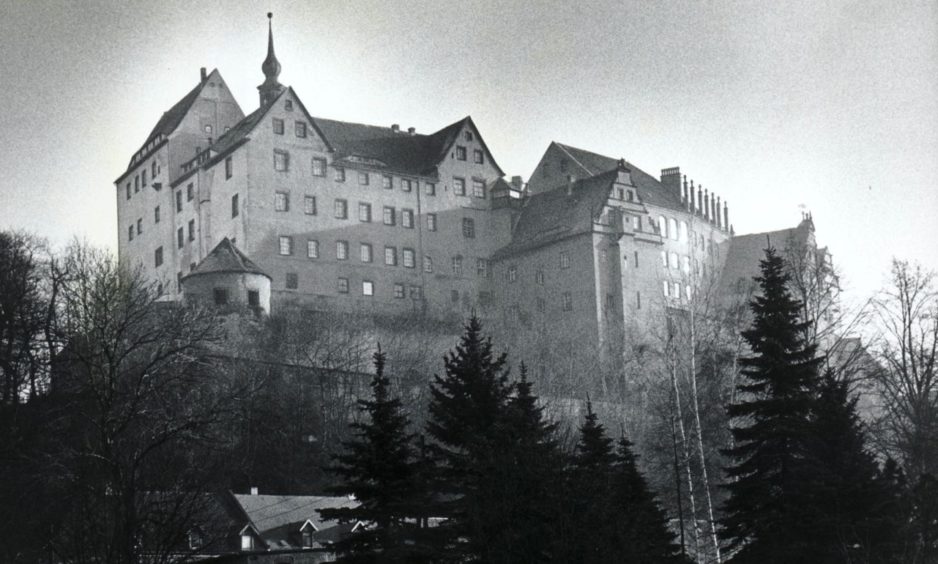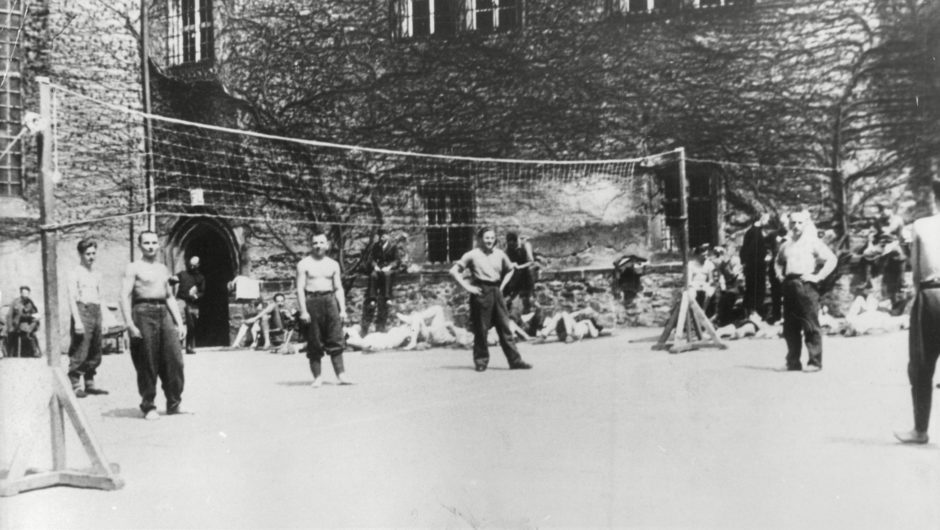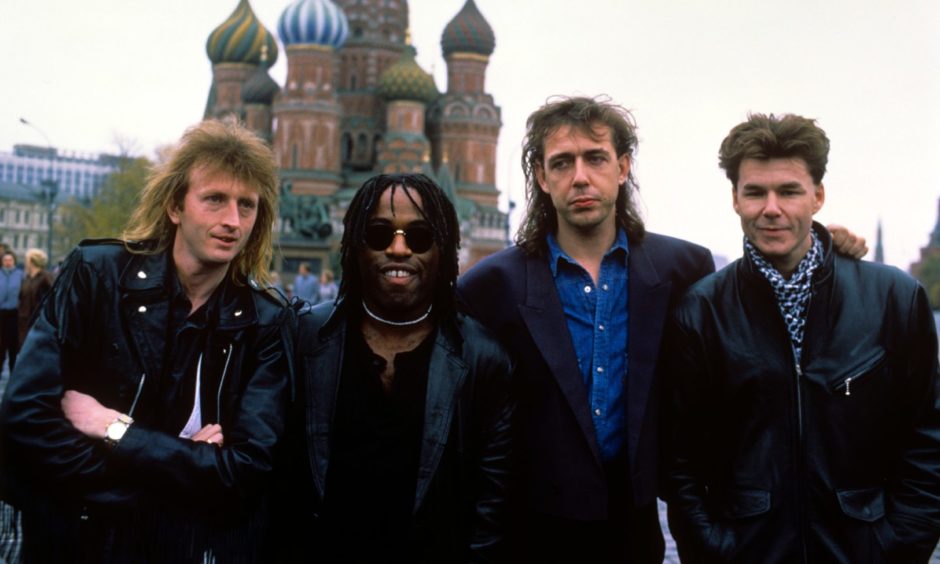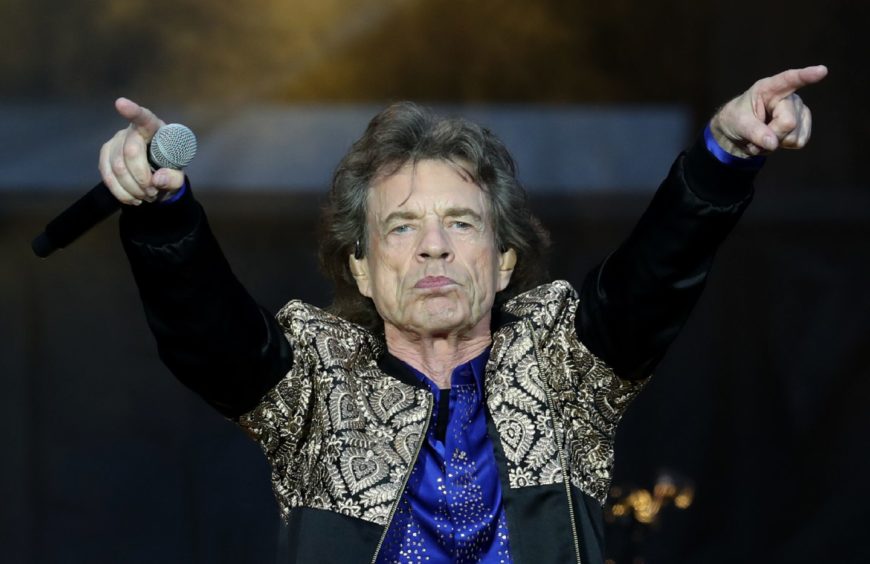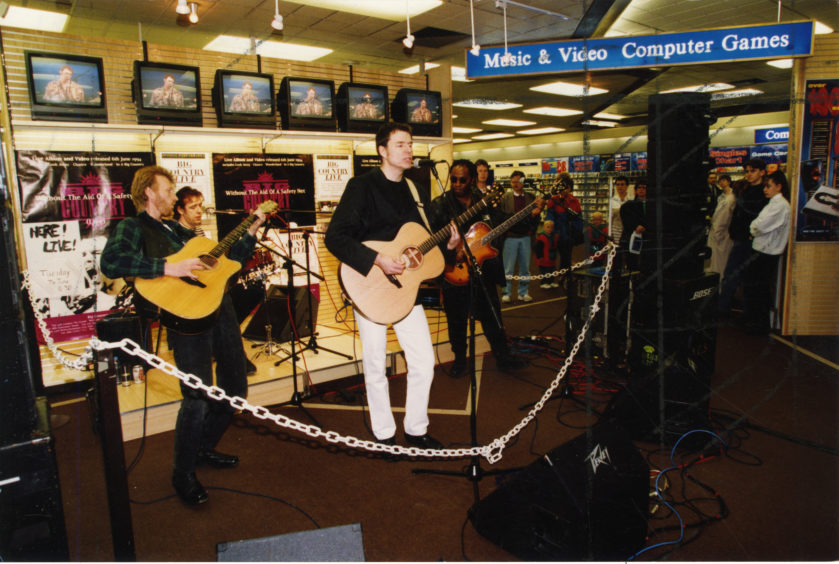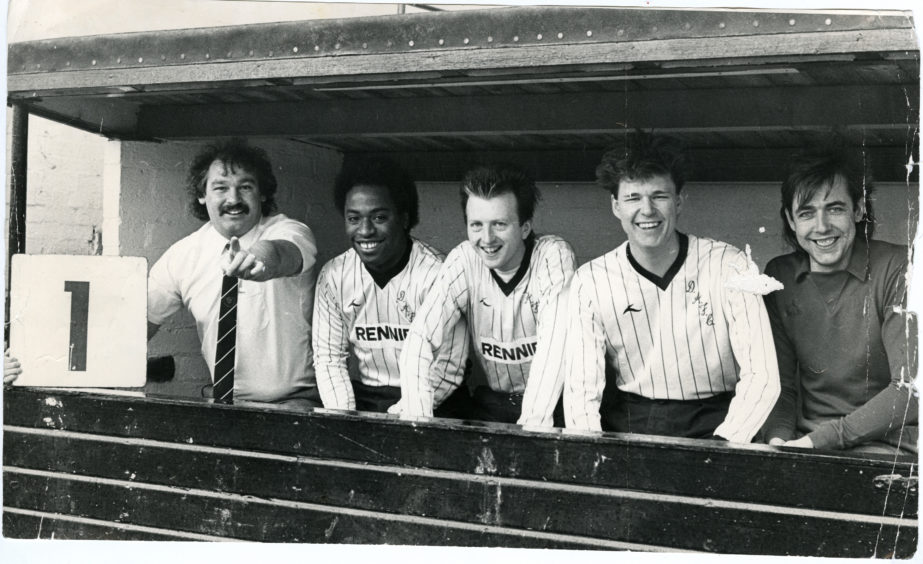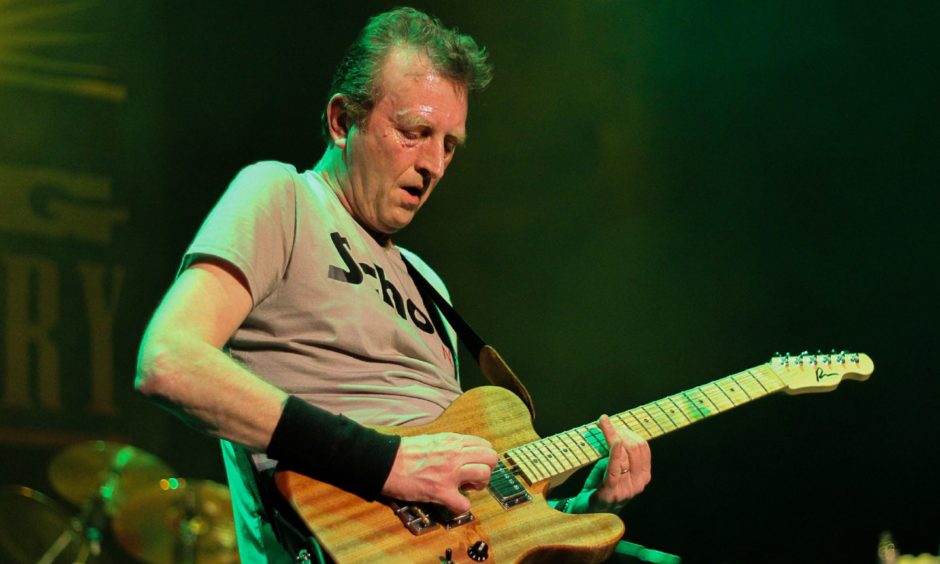
It was the day Big Country guitarist Bruce Watson found himself locked up inside the Nazi’s “inescapable” Colditz prison.
The band, which was formed in Dunfermline in 1981, was supporting the Rolling Stones on the Voodoo Lounge European tour when they came across Colditz between Leipzig and Berlin.
Colditz was built on the side of a cliff above the Mulde river in the 11th century and gained international fame as a prisoner of war camp during the Second World War for ‘incorrigible’ Allied officers who had repeatedly escaped from other camps.
Big Country decided to investigate the castle “high on yonder hill” which “looked a bit familiar” before performing at the Olympic Stadium in Berlin 25 years ago in 1995.
Watson recalled: “It turns out that ‘Yonder Castle’ is none other than ‘Colditz’ castle, world famous for being the castle that is known as Colditz, slap bang in the middle of a small town, known locally as Colditz.
“We made our way into the ‘bad boys camp’ and found ourselves in the imposing courtyard.
“What a grim place to be incarcerated in I thought.
“It was a glorious sunny day on the outside of the castle walls but inside, the high walls ensured that no light got in.
“A scruffy looking chap approached us and in his best English told us that we could wander free around the court yard but to be reasonably quiet as the former POW camp was now in use as a mental hospital.
“‘Home at last I thought’ this would be the perfect place to spend an afternoon that would usually entail sitting on a tour bus with the same people that one has spent the last 15 years sitting on a tour bus with.
“I decided to leave the group to get a smoke then some shut-eye.
“I wandered off into this room which I found out later was where they kept the Dutch prisoners.
“I don’t know if it was the effect of the ‘welding rods’ or maybe I was just too tired but I was awakened an hour later by our scruffy friend.
“Seemingly I had wandered into another part of the castle and got my self locked in a wine cellar.
“The only way out was through one of the ill-fated tunnels that were partially concrete’d up.
“I was told that luckily I was still in the non-hospital side of the castle because if I was caught in the working part they would have kept me in thinking I was a patient trying to go ‘walkies’.”
Stuart Adamson formed an early version of Big Country with Bruce Watson in Dunfermline in 1981.
The former Skids guitarist recruited bassist Tony Butler and drummer Mark Brzezicki, both top London session players, within a year.
Released in 1983, the band’s debut album The Crossing went on to sell more than two million copies worldwide.
Second album Steeltown (1984) debuted at No 1 in the UK.
The Seer (1986) included the band’s biggest UK hit Look Away, which reached No 7 in the UK singles chart and spent a week at the top of the Irish singles chart.
The album Peace In Our Time (1988) saw the band playing the first ever privately promoted gig in Russia at the Moscow Sports Stadium.
The fifth studio album No Place Like Home (1991) took the Fife band’s total record sales to well over five million copies.
Further studio albums Buffalo Skinners (1993) and Why The Long Face (1995) followed, which saw Big Country landing the special guest slot on the Voodoo Lounge European tour.
The tour grossed $320 million, replacing Pink Floyd’s Division Bell tour as the highest grossing of any artist at that time.
Rooster-strutting Stones frontman Mick Jagger hailed Big Country as one of the Rolling Stones’ best-ever opening acts following the tour.
Watson returned the compliment when he said the Rolling Stones were the only band Big Country supported that he wanted to watch every night.
He said: “Sometimes we would go out front and sometimes we would watch from behind Charlie, or next to Keith and Ronnie’s amps.
“I remember having a chuckle when Charlie scolded ‘Keef’ and ‘Woody’ for not using ashtrays on stage.
“One highlight was singing the backing vocals to Sympathy For The Devil with Bernard Fowler side stage.
“Charlie and Mark got on well and Charlie would sometimes check him out from backstage.”
In 1998 they were once again invited to open for the Stones on their Bridges To Babylon tour of Europe.
The Big Country album Driving to Damascus was released in 1999 before troubled lead singer Adamson took his own life in Honolulu in 2001.
Aside from tribute shows following his death, the remaining three members had no real thoughts of performing as Big Country again, although Butler, Brzezicki and Watson re-united in 2007 to celebrate the band’s 25th anniversary.
However, it took another three years before, in the summer of 2010, Watson finally picked up the phone and asked Alarm singer Mike Peters to do what he had previously been reluctant to do and sing with Big Country officially.
They put the band back on the road with Watson’s son, Jamie, joining on guitar, and the “new” Big Country was fuelled by a renewed energy and once again revelling in the dreams and visions that had brought them together in the first place.
Further line-up changes happened in 2012, when Butler retired from the group, to be replaced by former Simple Minds bassist Derek Forbes.
The group also parted ways with longtime manager Ian Grant at the same time as Butler’s departure.
Mike Peters left Big Country in November 2013.
Now with singer Simon Hough and bassist Scott Whitley they are touring as strongly as ever and still filling venues from across Europe and Australia to hometown Dunfermline.
A political prison for communists, homosexuals, Jews, and other “undesirables”
Colditz Castle has stood since the Middle Ages and has in the past been used as a workhouse and a mental institution.
The first castle was built during the late 11th century AD at the order of powerful German king Henry IV.
From then on the castle played an important role as a watchtower for the German monarchy.
In 1504, an accidental fire destroyed a large part of the castle and its reconstruction saw new buildings added to the site.
In 1523 the castle grounds was turned into one of the largest zoos in Europe.
The castle structure was changed again under the long reign of the elector Augustus of Saxony from 1553 to 1586.
The condition of the once proud castle was allowed to deteriorate during the 19th century, when Colditz was used by Frederick Augustus III as a workhouse to feed the poor, the ill and those under arrest in the city.
In 1829 the workhouse at the castle was taken over by an institution in Zwickau and it became a mental hospital for the “incurably insane”.
From 1829 to 1924 Colditz was a high-profile sanitarium, generally reserved for the wealthy and the nobility of Germany.
Colditz was first used as an official prisoner of war camp during World War One, although no escapes were made at this time.
However, when the Nazis came to power in 1933, they turned the castle into a political prison for communists, homosexuals, Jews, and other “undesirables”.
It was not until 1939 that Allied prisoners were housed there.
Its outer walls were seven feet thick and the cliff on which it was built had a sheer drop of 250ft to the River Mulde below.
There were many famous Allied prisoners imprisoned in Colditz and these included British fighter ace Douglas Bader; Patrick Reid, the man who made Colditz famous with his post-war books; and Airey Neave, the first British officer to escape from Colditz and who later became a British MP.
On 7/2/1940, double leg amputee Douglas Bader rejoins front line service flying Spitfires with 19 Squadron. Later he would champion the controversial “Big Wing” tactic in the Battle of Britain, and record 23 “kills” before becoming a POW in the renowned Colditz. #LestWeForget pic.twitter.com/u5la8K43vb
— Paul Roe (@ChirpyRoe) February 7, 2020
Others included New Zealand British Army Captain Charles Upham, who was the only combat soldier to ever receive the Victoria Cross twice; and Sir David Stirling, founder of the wartime Special Air Service.
Prisoners who were relatives of Allied VIPs could potentially be used by Hitler as bargaining tools; these individuals were known as Prominente.
Despite being a daunting prospect, there were a number of escape attempts, each using a range of plans.
Some prisoners even managed to communicate with the outside world including coded letters which a British spy sent to his Fife parents.
Born in 1912, Julius Morris Green spent his early childhood in Killarney where his father had a dental practice.
He studied at the Dental School of the Royal College of Surgeons in Edinburgh and was practising in Glasgow when he joined the Territorial Army in 1939, being posted to the 152 (H) Field Ambulance of the 51 Highland Division.
He was captured with his brigade at St Valery in June 1941 and spent the remainder of the war in a succession of camps, his misbehaviour meaning that he eventually received the honour of being confined to Oflag IV-C
In April 1945, US troops entered Colditz town to conquer the castle.
